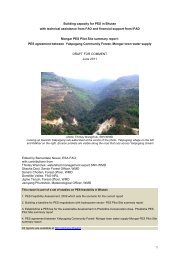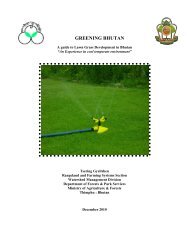Humanâwildlife conflict in the Kingdom of Bhutan: Patterns ... - DoFPS
Humanâwildlife conflict in the Kingdom of Bhutan: Patterns ... - DoFPS
Humanâwildlife conflict in the Kingdom of Bhutan: Patterns ... - DoFPS
Create successful ePaper yourself
Turn your PDF publications into a flip-book with our unique Google optimized e-Paper software.
ARTICLE IN PRESS<br />
10 BIOLOGICAL CONSERVATION xxx (2008) xxx– xxx<br />
<strong>of</strong> <strong>Bhutan</strong> is characterized by high elevation alp<strong>in</strong>e grasslands<br />
and sparsely populated by semi-nomadic livestock herders.<br />
Because <strong>of</strong> <strong>the</strong> nomadic lifestyle, where cattle and yak are<br />
moved seasonally between high elevations <strong>in</strong> summer and<br />
lower elevations <strong>in</strong> w<strong>in</strong>ter (Moktan et al., 2006), <strong>the</strong>re is little<br />
<strong>in</strong>frastructure available for stock protection, and stock are<br />
more likely to be free range dur<strong>in</strong>g <strong>the</strong> non-w<strong>in</strong>ter months.<br />
Competition between livestock and native herbivores is probably<br />
also heightened <strong>in</strong> this region, perhaps necessitat<strong>in</strong>g that<br />
carnivores prey on <strong>the</strong> abundant livestock that have replaced<br />
native herbivores <strong>in</strong> some areas. Mishra et al. (2001) document<br />
widespread overstock<strong>in</strong>g <strong>of</strong> <strong>the</strong> rangelands <strong>of</strong> <strong>the</strong><br />
trans-Himalayan region <strong>of</strong> India and show that this can lead<br />
to reduction <strong>in</strong> native herbivore numbers (Mishra et al.,<br />
2001) which <strong>in</strong> turn has been l<strong>in</strong>ked to <strong>in</strong>creased predation<br />
<strong>of</strong> livestock by wild carnivores (Bagchi and Mishra, 2006).<br />
More research on livestock numbers, graz<strong>in</strong>g pressure and<br />
livestock husbandry practices <strong>in</strong> <strong>the</strong> nor<strong>the</strong>rn rangelands <strong>of</strong><br />
<strong>Bhutan</strong> is warranted <strong>in</strong> order to understand more fully <strong>the</strong><br />
reasons for <strong>the</strong> high levels <strong>of</strong> predation we observed <strong>the</strong>re.<br />
5. Conclusions<br />
Human–wildlife <strong>conflict</strong> is a complex facet <strong>of</strong> wildlife management,<br />
and <strong>in</strong> <strong>Bhutan</strong> as elsewhere, careful management<br />
will be required if <strong>the</strong> duel goals <strong>of</strong> wildlife conservation<br />
and economic livelihood for pastoralists are to be met. Wang<br />
et al. (2006) showed that farmers <strong>in</strong> central <strong>Bhutan</strong> were <strong>in</strong>terested<br />
<strong>in</strong> <strong>of</strong>fer<strong>in</strong>g ways that human–wildlife <strong>conflict</strong> can be reduced,<br />
but were frustrated by livestock predation which <strong>in</strong><br />
turn cultivated an alarm<strong>in</strong>gly high support for exterm<strong>in</strong>ation<br />
<strong>of</strong> problem wildlife. Our aim <strong>in</strong> this paper was to provide<br />
knowledge that can help government agencies <strong>in</strong> <strong>Bhutan</strong> formulate<br />
countrywide strategies for mitigat<strong>in</strong>g livestock losses,<br />
and ultimately, help conserve predator populations through<br />
reduction <strong>in</strong> human–wildlife <strong>conflict</strong>s.<br />
Our data show that leopards are <strong>the</strong> dom<strong>in</strong>ant livestock<br />
predator <strong>in</strong> <strong>Bhutan</strong>, a factor probably related to <strong>the</strong>ir numerical<br />
abundance compared to o<strong>the</strong>r predators covered by <strong>the</strong><br />
TCF. Leopards probably prefer to hunt <strong>the</strong> smaller or more<br />
easily tackled livestock, and <strong>in</strong> our study <strong>the</strong>y were responsible<br />
for almost all <strong>of</strong> <strong>the</strong> calf and foal kills, most <strong>of</strong> <strong>the</strong> sheep<br />
and horse kills, and more than half <strong>of</strong> cow kills. Therefore,<br />
measures aimed at reduc<strong>in</strong>g livestock predation <strong>in</strong> <strong>Bhutan</strong><br />
should focus on leopards as <strong>the</strong> key predator, and cows,<br />
horses, sheep and juvenile livestock as <strong>the</strong> key targets. In<br />
areas where tigers are prevalent, our data suggest that measures<br />
should be taken to protect <strong>the</strong> larger and more valuable<br />
livestock such as bull cattle, although presumably, <strong>in</strong> <strong>the</strong> absence<br />
<strong>of</strong> larger livestock, tigers would switch to o<strong>the</strong>r available<br />
livestock types.<br />
Generally, horses are <strong>the</strong> most vulnerable livestock type, a<br />
factor that is probably related <strong>in</strong> part to <strong>the</strong>m be<strong>in</strong>g allowed to<br />
graze unprotected when not be<strong>in</strong>g used for <strong>the</strong>ir primary purpose<br />
<strong>of</strong> transportation. Horse kills formed a large part (about<br />
one third) <strong>of</strong> all livestock kills reported, and <strong>the</strong> number <strong>of</strong><br />
horses lost was greatly disproportionate to <strong>the</strong> number <strong>of</strong><br />
horses kept <strong>in</strong> each district compared with cattle, so programs<br />
that aim to encourage animal husbandry methods that<br />
would protect horses from predation would likely lead to a<br />
significant decl<strong>in</strong>e <strong>in</strong> overall livestock predation rates by predators<br />
across <strong>Bhutan</strong>. Our analyses suggest that geographical<br />
and seasonal affects were also at play, so programs aimed at<br />
encourag<strong>in</strong>g greater vigilance aga<strong>in</strong>st livestock predators <strong>in</strong><br />
nor<strong>the</strong>rn dzongkhags, where predation was greatest, and dur<strong>in</strong>g<br />
<strong>the</strong> summer months when cropp<strong>in</strong>g agriculture is at a<br />
peak and livestock are less well guarded, would also be beneficial<br />
<strong>in</strong> curb<strong>in</strong>g livestock losses.<br />
F<strong>in</strong>ally, work <strong>in</strong> <strong>Bhutan</strong> (Wang et al., 2006) and elsewhere<br />
(e.g. Oli et al., 1994) demonstrate that <strong>the</strong> success <strong>of</strong> any predation<br />
mitigation measures require <strong>the</strong> full engagement <strong>of</strong><br />
farmers <strong>in</strong> wildlife management decisions, concurrent with<br />
<strong>the</strong> implementation <strong>of</strong> strategies aimed to educate <strong>the</strong> public<br />
about <strong>the</strong> value <strong>of</strong> nature conservation. Lessons learned <strong>in</strong><br />
o<strong>the</strong>r programs aimed at manag<strong>in</strong>g human–wildlife <strong>conflict</strong>s<br />
around <strong>the</strong> world should <strong>the</strong>refore be useful <strong>in</strong> formulat<strong>in</strong>g a<br />
response to <strong>the</strong> problem <strong>in</strong> <strong>Bhutan</strong>.<br />
Acknowledgements<br />
We would like to thank <strong>the</strong> Royal Government <strong>of</strong> <strong>Bhutan</strong> for<br />
<strong>the</strong> opportunity to undertake this work. Thanks are due to<br />
Dr. Sangay Wangchuk and Mr. Sherub, (Nature Conservation<br />
Division), Mr. K<strong>in</strong>zang Namgay, (Country Representative,<br />
World Wide Fund for Nature), and Mr. Chado Tenz<strong>in</strong> (FAO<br />
<strong>Bhutan</strong>) for <strong>the</strong>ir guidance and unfail<strong>in</strong>g support to <strong>the</strong> compensation<br />
scheme. We would like to also acknowledge <strong>the</strong><br />
support <strong>of</strong> <strong>the</strong> verify<strong>in</strong>g staff (community leaders, veter<strong>in</strong>arians,<br />
foresters and park staff) for help<strong>in</strong>g <strong>in</strong> data collection,<br />
<strong>in</strong>vestigation and verification <strong>in</strong> <strong>the</strong> field. Dr. Andrew Boulton<br />
(University <strong>of</strong> New England) provided statistical guidance, and<br />
an anonymous reviewer provided valuable advice for improv<strong>in</strong>g<br />
earlier versions <strong>of</strong> this manuscript. F<strong>in</strong>ally, we would also<br />
like to thank WWF <strong>Bhutan</strong>, <strong>the</strong> US Fish and Wildlife Foundation,<br />
and Save <strong>the</strong> Tiger Fund for <strong>the</strong>ir sponsorship <strong>of</strong> <strong>the</strong> tiger<br />
conservation fund; and Ms. Nancy Abraham for her personal<br />
assistance with f<strong>in</strong>anc<strong>in</strong>g <strong>the</strong> compensation scheme <strong>in</strong> <strong>the</strong><br />
<strong>Bhutan</strong>.<br />
REFERENCES<br />
Allen, L.R., Sparkes, E.C., 2001. The effect <strong>of</strong> d<strong>in</strong>go control on<br />
sheep and beef cattle <strong>in</strong> Queensland. Journal <strong>of</strong> Applied<br />
Ecology 38, 76–87.<br />
Bagchi, S., Mishra, C., 2006. Liv<strong>in</strong>g with large carnivores: predation<br />
on livestock by <strong>the</strong> snow leopard (Uncia uncia). Journal <strong>of</strong><br />
Zoology 268, 217–224.<br />
Biswas, S., Sankar, K., 2002. Prey abundance and food habit <strong>of</strong><br />
tigers (Pan<strong>the</strong>ra tigris tigris) <strong>in</strong> Pench National Park, Madhya<br />
Pradesh, India. Journal <strong>of</strong> Zoology 256, 411–420.<br />
Ciucci, P., Boitani, L., 1998. Wolf and dog depredation on livestock<br />
<strong>in</strong> central Italy. Wildlife Society Bullet<strong>in</strong> 26, 504–514.<br />
Espuno, N., Lequette, B., Poulle, M.L., Migot, P., Lebreton, J.D., 2004.<br />
Heterogeneous response to preventive sheep husbandry<br />
dur<strong>in</strong>g wolf recolonization <strong>of</strong> <strong>the</strong> French Alps. Wildlife Society<br />
Bullet<strong>in</strong> 32, 1195–1208.<br />
Fox, J.L., Chundwat, R.S., 1988. Observations <strong>of</strong> snow leopard<br />
stalk<strong>in</strong>g, kill<strong>in</strong>g and feed<strong>in</strong>g behavior. Mammalia 52, 137–140.<br />
Please cite this article <strong>in</strong> press as: Sangay, T., Vernes, K., Human–wildlife <strong>conflict</strong> <strong>in</strong> <strong>the</strong> K<strong>in</strong>gdom <strong>of</strong> <strong>Bhutan</strong>: <strong>Patterns</strong> ..., Biol.<br />
Conserv. (2008), doi:10.1016/j.biocon.2008.02.027





